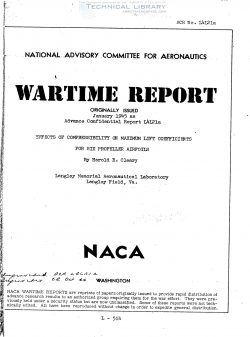naca-wr-l-514
- Version
- 117 Downloads
- 622.58 KB File Size
- 1 File Count
- April 2, 2017 Create Date
- April 2, 2017 Last Updated
Effects of Compressibility on Maximum Lift Coefficients for Six Propeller Airfoils

SUEHARY
An extension of previously reported data on the
variation of maximum lift coefficient with Mach number,
camber, and thickness ratio is presented. The data were
obtained from pressure-distribution tests in the
Langley 8-foot high-speed tunnel of six propeller air-
foils of l-foot chord.
It was found that the maximum lift coefficients of
all the airfoils were markedly affected by compressibility
at Mach numbers as low as 0.2. At Mach numbers above
the order of 0.h5,large increases in maximum lift
coefficient occurred. The combination of a thickness
ratio of 0.15 and a design lift coefficient of 0.7 was
found to be critical, with adverse effects on maximum
lift coefficient occurring over most of the speed range
investigated.
INTRODUCTION
It has been pointed out in reference 1 that the
prediction of high-lift performance of airfoils at high
speeds based on low-speed data can be seriously in error.
The low critical speeds occurring at high lifts and the
separation produced by severe pressure gradients over
the airfoil affect the maximum lift coefficient at
Mach numbers as low as 0.2. It was also indicated that
large increases in the maximum lift coefficient are to
be expected at values of Mach number above 0.5. The
data presented herein include an extension to higher
Mach numbers of the data for the three airfoils presented
in reference 1 as well as data for three additional air-
foils tested to establish.more definitely the effects of
camber and thickness ratio.
2 NAGA ACR No. 1.1.1.211:
The effects of compressibility on maximum lift coef-
ficient as presented in reference 1 and herein have
particular application to propeller performance at take-
off and some climb conditions. These applications
combine high-lift loadings on the blades with high speeds
over a considerable portion of the blades.
The tests were conducted in the Langley 8—foot high-
speed tunnel on'models of l-foot chord to obtain full—
scale propeller Reynolds numbers and reduced tunnel-wall
effects. Measurements consisted, principally, of the
pressure distribution at the center of the airfoil model.
This method of measurement gives effectively two-dimensional
results, which best illustrate the type of phenomenon that
occurs.
| File | Action |
|---|---|
| naca-wr-l-514 Effects of Compressibility on Maximum Lift Coefficients for Six Propeller Airfoils.pdf | Download |

Comment On This Post